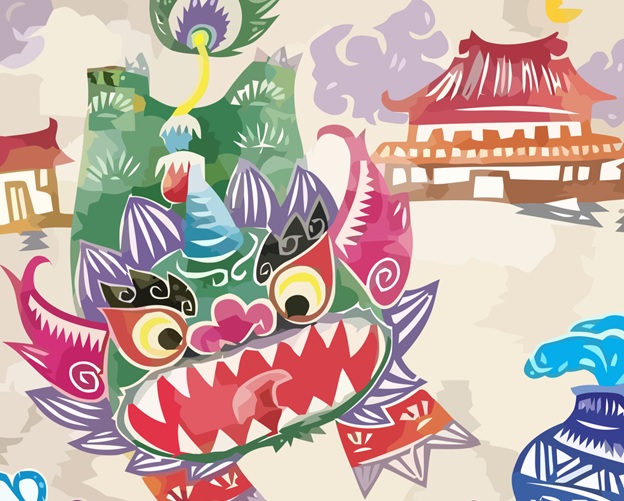Do you know why is the word “year” is “年 (nián)” in Chinese? And also why the “new year” is also called as “過年 (guònián)”?
[otw_shortcode_tabslayout tabs=”2″ tab_1_title=”Simplified Chinese” tab_1_content=”春节的历史很悠久,传说早在新石器时期时就有过「春节」的风俗了。
关于「春节」的起源,有一种传说是:中国古时候有一种兽叫做「年」。 「年」长年深居海底,但每到特定的一天(现在说的除夕)就爬上岸,吞食牲畜,伤害人命。因此,每到除夕这天,村村寨寨的人们逃往深山,以躲避「年」兽的伤害。
有一年除夕,从村外来了个乞讨老人。乡亲们一片匆忙恐慌,没人答理这个乞讨老人,只有村东头一位老婆婆给了老人些食物,并劝他快上山躲避「年」兽,那老人把胡子撩起来笑道:「婆婆若让我在家呆一夜,我一定把“年”兽赶走。」老婆婆继续劝说,乞讨老人笑而不语。
半夜时分,「年」兽闯进村。它发现村里气氛与往年不同:村东头老婆婆家,门贴大红纸,屋内烛火通明。 「年」兽浑身一抖,怪叫了一声。将近门口时,院内突然传来「砰砰啪啪」的炸响声,「年」浑身战栗,再不敢往前凑了。
原来,「年」最怕红色、火光和炸响。这时,婆婆的家门大开,只见院内一位身披红袍的老人在哈哈大笑。 「年」大惊失色,狼狈逃蹿了。第二天是正月初一,避难回来的人们见村里安然无恙,十分惊奇。这时,老婆婆才恍然大悟,赶忙向乡亲们述说了乞讨老人的许诺。
这件事很快在周围村里传开了,人们都知道了驱赶「年」兽的办法。从此每年,家家贴红对联、燃放爆竹。初一一大早,还要走亲访友。这风俗广泛流传,成了中国民间最重要的传统节日。
” tab_2_title=”Traditional Chinese” tab_2_content=”
春節的歷史很悠久,傳說早在新石器時期時就有過「春節」的風俗了。
關於「春節」的起源,有一種傳說是:中國古時候有一種獸叫做「年」。 「年」長年深居海底,但每到特定的一天(現在說的除夕)就爬上岸,吞食牲畜,傷害人命。因此,每到除夕這天,村村寨寨的人們逃往深山,以躲避「年」獸的傷害。
有一年除夕,從村外來了個乞討老人。鄉親們一片匆忙恐慌,沒人答理這個乞討老人,只有村東頭一位老婆婆給了老人些食物,並勸他快上山躲避「年」獸,那老人把鬍子撩起來笑道:「婆婆若讓我在家呆一夜,我一定把“年”獸趕走。」老婆婆繼續勸說,乞討老人笑而不語。
半夜時分,「年」獸闖進村。它發現村里氣氛與往年不同:村東頭老婆婆家,門貼大紅紙,屋內燭火通明。 「年」獸渾身一抖,怪叫了一聲。將近門口時,院內突然傳來「砰砰啪啪」的炸響聲,「年」渾身戰栗,再不敢往前湊了。
原來,「年」最怕紅色、火光和炸響。這時,婆婆的家門大開,只見院內一位身披紅袍的老人在哈哈大笑。 「年」大驚失色,狼狽逃躥了。第二天是正月初一,避難回來的人們見村里安然無恙,十分驚奇。這時,老婆婆才恍然大悟,趕忙向鄉親們述說了乞討老人的許諾。
這件事很快在周圍村里傳開了,人們都知道了驅趕「年」獸的辦法。從此每年,家家貼紅對聯、燃放爆竹。初一一大早,還要走親訪友。這風俗廣泛流傳,成了中國民間最重要的傳統節日。
“][/otw_shortcode_tabslayout]
English translation:
The history of the Spring Festival is very long. It is said that there was a custom of “Spring Festival” as early as the Neolithic period.
There is a legend about the origin of the “Spring Festival”: In ancient China, there was a beast called “Nian.” The “Nian” lived deep in the sea for throughout the year, but every time in a special day (now said New Year’s Eve), it would climb ashore, swallows livestock, and harms people. Therefore, on the day of New Year’s Eve, the people in every village fled to the mountains to escape from the “Nian” beast.
On one New Year’s Eve, there was an old beggar from the outside of the village. The villagers were in a hurry and panic, and no one paid attention to the old beggar. Only the old woman at the east end of the village gave the old man some food and advised him to go up the mountain to avoid the “Nian” beast. The old man picked up his beard and smiled: “If you let me stay at home for one night, I will definitely drive away the “Nian” beast.” The old woman continued to persuade, but the old man only laughed and not said anything.
In the middle of the night, the “Nian” beast entered the village. It found that the atmosphere in the village was different from that of previous years: the old woman’s house at the east end of the village, the door was covered with red paper, and the house was full of candles. The “Nian” beast screamed weirdly. When it approached the door, there was a sudden sound of “loud bangs” in the courtyard. “Nian” was shuddering and did not dare to go forward.
It turns out that the “Nian” is most afraid of red, fire and explosion. At this time, the old woman’s house door opened wide, and there appeared a man in the yard wearing a red robe laughing. The “Nian” turned pale with fright, and fled in panic. The next day was the first day of the first month. People who came back from the refuge were very surprised when they saw the village safe and sound. At this time, the old woman realized suddenly and quickly told the villagers about the promise of the old man.
This matter quickly spread in the surrounding villages, and the people all now know how to drive away the “Nian” beast. Every year since then, the family posted red paper couplets and set off firecrackers. In the early morning of the first day of the morning, they will also visit friends and relatives. This custom has been then widely circulated and has become the most important traditional festival of Chinese folk.
Special notes:
- 頭 – tóu – the end of (a place)
- 戰栗 – zhànlì – tremble, shiver
- 炸響 – zhà xiǎng – sound of explosion
- 狼狽逃躥 – lángbèi táo cuān – flee in panic
The photo is taken from here.

